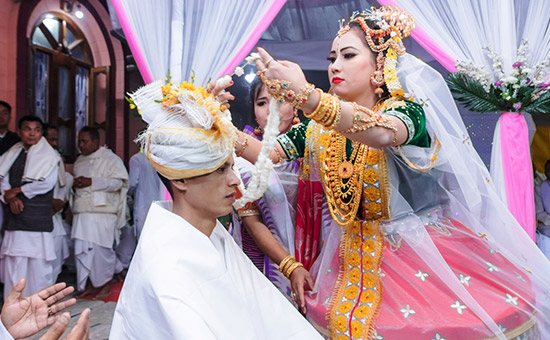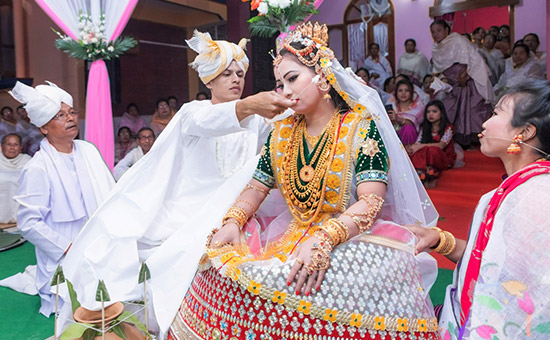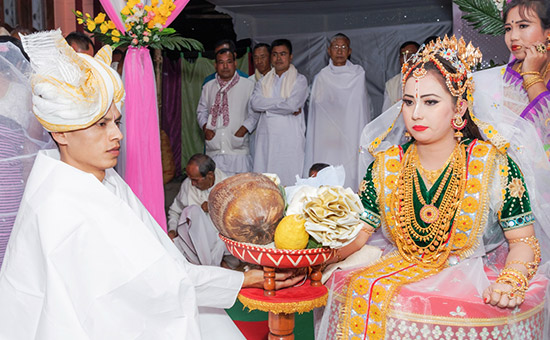- Article
explains the Manipuri marriage ritual in some detail.
- All
ceremonies including the wedding are conducted around the Tulsi plant.
The
Meetei or Manipuri people, are small in population, have a glorious culture and
tradition. Manipur has its own tradition, civilization and history going back
over 2,500 years. The Manipuris had their own Tibeto-Burman religion worshiping
own Gods and Goddesses besides Hinduism which entered the state in the 18th
century. Modern day Manipur has an area of 22,327 square kms.
Manipuris observe the Lai-Harouba ceremony during the summer offering flowers,
new vegetables and fruits for peace and prosperity of the land. The Meetei
believed the rituals, songs and dances associated with Lai-Harouba are the
foundation of modern day Manipuri dance and music.
An
oval shaped green valley surrounded by nine hill ranges, rich in tradition has
inspired people to call Manipur the “Switzerland of the East” and the “Jewel of
India”. The people of Manipur include the Meeteis, Nagas, Kuki-Chin-Mizo, Manipuri
Muslims and many others coming from different parts of the country.
Geographically, Manipur shares an international border with Myanmar in the East
and has state boundaries with North Eastern States.
The forms of marriage prevalent in Meitei society are Marriage by engagement,
Marriage by elopement and Court marriage (few in number if necessary). Marriage within the clan or yek is strictly prohibited. This is a long time honoured
custom in the Meitei society. The marriage by engagement is the purest and highest
form of marriage and the basis of regular Meitei marriage.
Marriage is a social contract for the satisfaction of physical, biological,
psychological and spiritual needs of Man and Woman leading to the formation of
a family. Thus, the growth and development as well as the stability of human
society depend upon this universal and primary institution. On account of this
vital importance, the sanctity and permanence of marriage has been emphasized
in Meitei Society.
The
Meitei concept of marriage implies the sacred and ceremonial union of a man and
a woman with due religious rites. The local term for marriage is “Luhongba”
which is a combination of two words, “Lu” which means “head” in archaic
Manipuri and “Hongba” to solemnize. Hence, Luhongba is the ceremonial union of
the “Lu” of the man and the woman implying the oneness of their heart and soul
rather than the state of their being a couple.
In Meitei society child marriage was totally unknown. Widow re-marriage is allowed
with a restriction that a widow cannot marry her deceased husband’s brother and
relatives. No practical ceremony is performed for widow remarriage.
The
Manipuri marriage has a two customary system among the Vaishnavites and
traditional Meeteis, most of whom reside in the valley areas of Manipur. The
parents and guardians select the life partner for their son or daughter. After the
parents, of boy and girl, reach a mutual understanding the date is fixed.
Both sides get the horoscope of the bride and groom examined by astrologers who
give the final dates for the marriage ceremonies. This type of marriage is
known as Gandharva Vivah.
Another
form of marriage is when the bride and groom fall in love (love marriage). In this form of marriage the groom elopes
with the bride. On the morning of the next day the male elders of the groom
informs the bride’s family. By afternoon a team of women escort the bride to
her house. Later on, the parents of both side complete other formalities.
The actual process of marriage starts two to three days before with the Heijing Kharai Puba (Heijingpot): This
is the most important of all the preliminary stages of marriage. Different
types of gifts, fruits, sweets, items for God and clothes for the girl are
given by the Groom’s side. Among the fruits, two fruits namely Heikru (ambalica) and Heining (Spondias mangi fera) must
necessarily be included.
Unlike
other preliminaries, Heijing Kharai Puba has a deeper social and religious
significance. On this day both the parties, meaning Groom and Bride, meet in
the house of the bride. In the evening the friends of the bride bring gifts and
eat together with the bride.
After
the Heijingpot ceremony one boy from the bride’s family goes to the house of
the Groom and extends an invitation to come for the marriage. This is known as Bor Barton touba (extending of
Invitation to the groom). This ritual was normally done in the afternoon. The boy
who came to extend an invitation to the groom was given some money, as a token,
by the groom’s family.
The family of the bride arrange house hall materials, bed, cupboard, sopha, television,
ornaments, clothes, utensils for the bride and her husband. These materials are
transported, in advance, to the house of the Groom on the day of the marriage
or earlier.
The
marriage invite is sent to friends and relatives well in advance before the
marriage ceremony. On the day of the marriage the Groom leaves his house around
2 to 2.30 pm, actual time depends upon how far his home is from the bride’s
home. Before leaving the Brahmin performs a ritual, the groom bows to his
parents and elders and leaves for the home of the bridge in a white decorated
Dhoti, Kurta and Turban as you see in cover pic.
The Groom, accompanied by his friends, carrying Mirror and Umbrella proceed
towards the home of the bride with a supervisor (male guide of the groom) and colour
full Band party. Normally the band party play modern musical instruments and
drums. In traditional styles, the traditional musical instruments like pena (oldest string instrument of
Manipur) and langden drum are played.
Before
the Groom party reaches the bride’s home a group of women carrying religious
items go to the house of the bride.
The
groom is received at the main gate of the house of the bride with sacred fire
from the side of the bride. The groom and his party are made to sit in an
enclosed area. Here the girl’s side arrange for Sankirtana music during which suitable religious lyrics are sung by
male and female singers in the courtyard of the bride’s house. Before
Vaishnavism entered Manipur the wedding ceremony was not accompanied by
Sankirtan as is done now.
In
every Meitei house the Tulsi or
Tairen Plant is grown over a raised rostrum. All
ceremonies including the wedding are conducted around this plant. The
bride circumnutates the groom seven times and on completion of each round she
throws flowers over the head of the Groom. On the seventh round she
places two garland of white flowers (Kundo)
around the neck of the Groom. The Groom then removes one of the garlands and
places the same around the neck of the bride.
 Bride puts garland of white flowers on groom.
Bride puts garland of white flowers on groom.
 Groom puts garland of white flowers on bride.
Groom puts garland of white flowers on bride.
The
main item of the ceremony is to solemnise the tie by sacrificial
ritual, either by the kindling of fire or installation of water pot. Kujaba Punba (tying of brides’ palm with
that of the groom) is an important ritual. The Groom with the help of the
supervisor/guide enter the Mandap. After bowing he sits on a well decorated
bench covered with red velvet/carpet cloth. He joins the ritual that would soon
be conducted by a Purohit/Brahmin – this ritual also involves the father or
elder brother of the bride.
The bride wearing beautiful embroidered well decorated stiff skirt (Potloi) and ornaments is brought out of
her home accompanied by her sister (see cover pic for her dress). She bows to
her father and then enters the middle of the Mandap where the Groom is sitting.
Both
hands of the bride and Groom are tied by a lady from the bride’s family who
also puts a beautiful coconut over their tied hands. The girl’s father places currency
notes, normally as a gift to the two, which will followed by other members of
the family, friends and relatives of the bride.
 Girl and boy hands below a container in which is coconut and placed money as gifts.
Girl and boy hands below a container in which is coconut and placed money as gifts.
Wedding ceremony is usually accompanied by Kirtans at which suitable religious lyrics are sung. Before Vaishnavism entered Manipur the wedding ceremony was not accompanied by Sankirtan as in done now.
The family members, relatives and friends of the bride see her off by going
together to the house of the Groom.
The marriage
ceremony ends with Mangani Chakouba (five
days feast) i.e. five days from marriage date. The family of the bride invite
the bride, Groom, groom family, relatives and friends to a grand feast-lunch at
the house of the bride. However, the bride cannot come to her parental home
before the completion of one month from the date of wedding. On completion of
the stipulated one month she comes accompanied by her mother-in-law.
Author is based in Imphal and runs a very
popular music group Rhythms of Manipur. His phone number s 91 89740 05015. Pictures that are shown in article are courtesy and copyright Babul Khuman.
Here
are video links to some of their performances.
1
Official Video
2
Dancing Drummers Rhythms
of Manipur, Sangai Festival 2015
3 Fusion Music Sangai Festival 2018